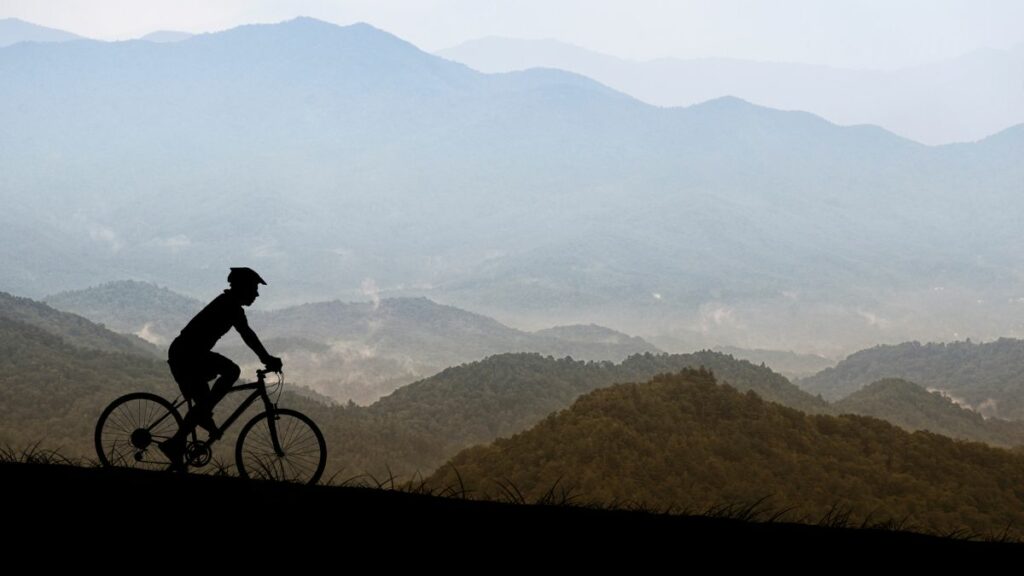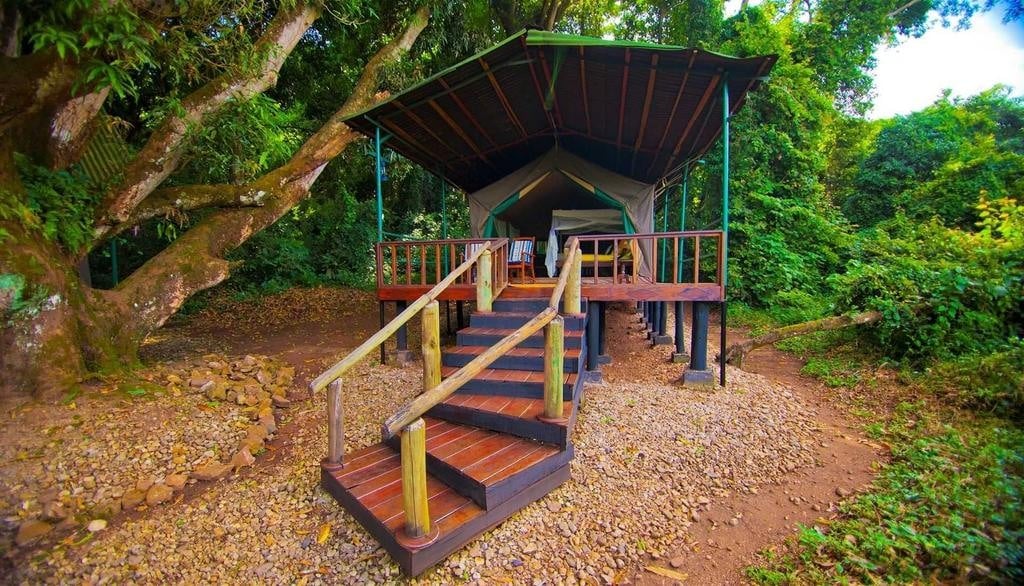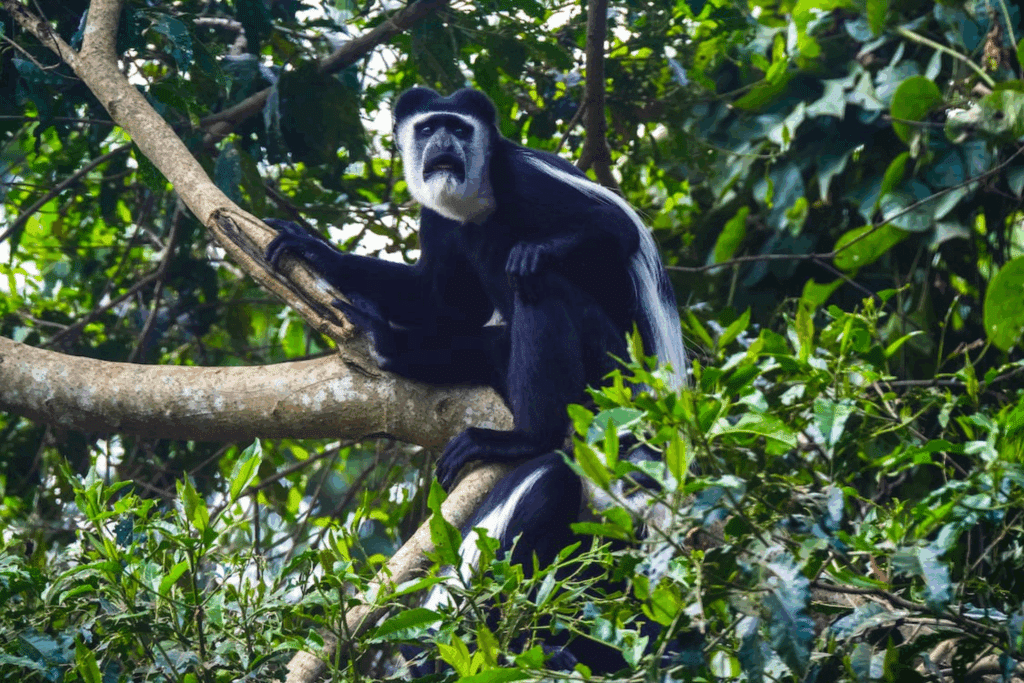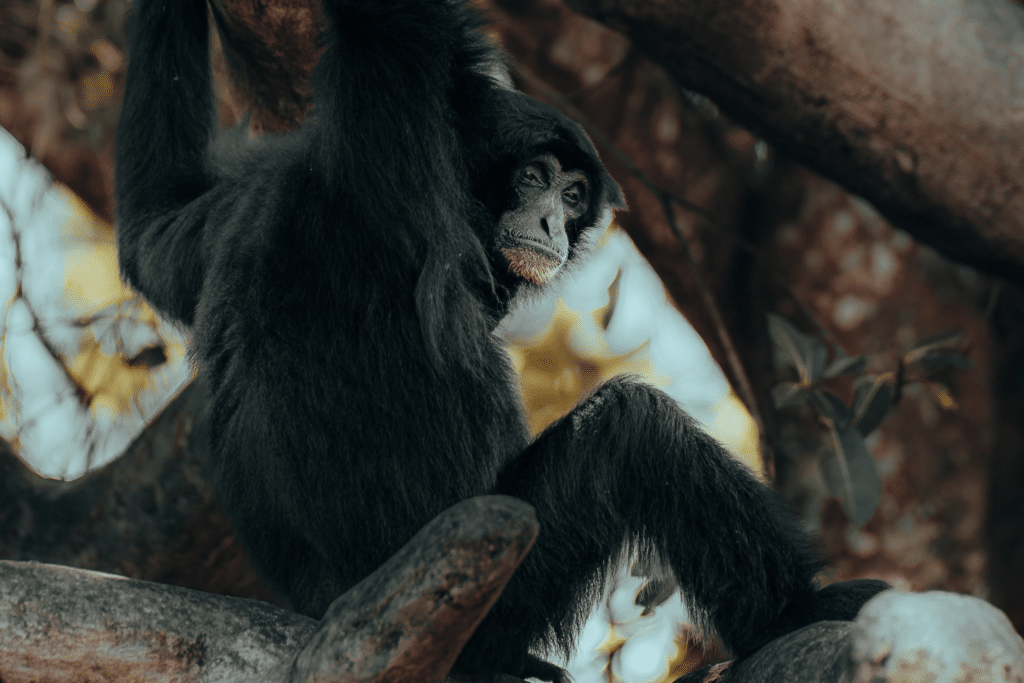Interested in meeting Tanzania’s last hunter-gatherers? Then, you should visit the Hadzabe tribe.
Our early morning start is almost forgotten as I marvel at how a bumpy, thirty-minute drive from our comfortable hotel has brought me in contact with this enchanting, alien world.
We stand on top of a rocky outcrop, maybe fifty metres high, and look out across the flatlands that stretch as far as we can see toward the shores of Lake Eyasi. To our right, in the middle distance, a small group of guinea fowl scamper away into the bushes.
My companions look longingly, fingering their wooden bows and arrows. But the quaint birds, which would make a tasty meal, are safely out of range. The five boys before me turn around, and I appraise them again. Their skin is smooth and dark, and their upper bodies are partially covered by the skins of baboons—previous kills.
Slim and athletic, with no excess weight, they look to my ignorant eye to be between ten and twenty years old. But this is only a guess: here, out in the wilderness, two worlds have collided, and my assumptions are based on my first-world, urban experience.
Tanzania – it’s not just the wildlife that’s fascinating
An encounter such as this with some Hadzabe tribesmen highlights my Tanzanian safari. Yes, I came expecting animals and spectacular wildlife, and Tanzania has not disappointed me at all.
But this is a bonus: a thought-provoking meeting with people who live and off the land. Later, back in the Land Cruiser, I reflect on my life with its excess worldly goods that out here in the bush seem wholly unnecessary.
But for now, the first world and the third are hunting together!
The hunt begins in Tanzania

With bows held at shoulder height, four Hadzabe youths fan out into a loose formation and silently enter the semi-scrub surrounding their camp, consisting of a handful of simple grass huts. The fifth and youngest boy hangs back to ‘look after’ me or perhaps out of curiosity.
He is about ten years old and turns occasionally to watch me, but his face shows no emotion. The older boys move quickly, and I struggle to keep up. But when I am motioned to slow down, I see that a small bird has settled on a treetop, and one of the older boys is about to lose his arrow with a view to a kill.
A soft whoosh accompanies the release, but a flutter of feathers heralds the bird’s escape. Arrows are all homemade, so a miss means the arrow must be retrieved or a replacement made. This is the duty of the youngest, and our hunt is halted while he shins the tree to recover it. Mission successful, we proceed once again through the bush.
Two more failed attempts follow before a shout announces that an arrow has at last hit home. Arriving at the scene, I can see that the winged victim is minor, the size of a mere sparrow. Hitting something of that size is a testament to Hadzabe’s accuracy…but it will not provide lunch; that much is certain!
Time for lunch: Fast food in 15 minutes in Tanzania with Hadzabe tribe
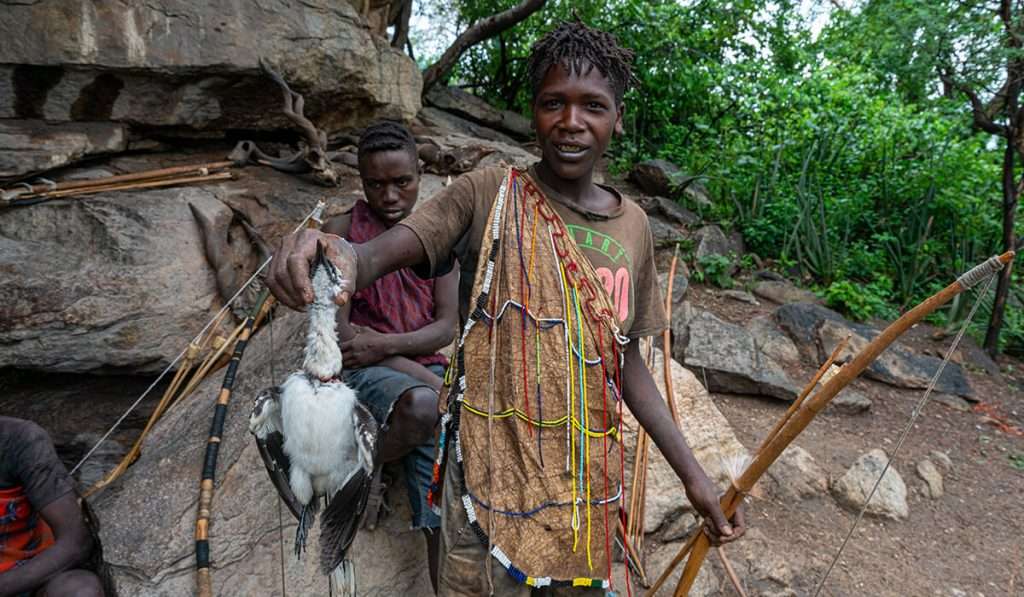
Again, the youngest boy is called into action. Perhaps he is earning his rite of passage, for it is his job to de-feather the tiny bird and collect the wood with which the older ones will start a fire, using a stone and a spear to create the necessary spark. Once cooked, the ‘meal’ is shared, though I decline.
The kill, de-feathering, cooking, and eating were accomplished in less than 15 minutes: unlike back home, there is no long cold chain here. ‘You eat what you kill’ has never seemed a more appropriate mantra, though I am sure the boys would have preferred to have one of those elusive guinea fowl, baboon, or kudu, which generally form the basis of their diet.
Culture and beliefs
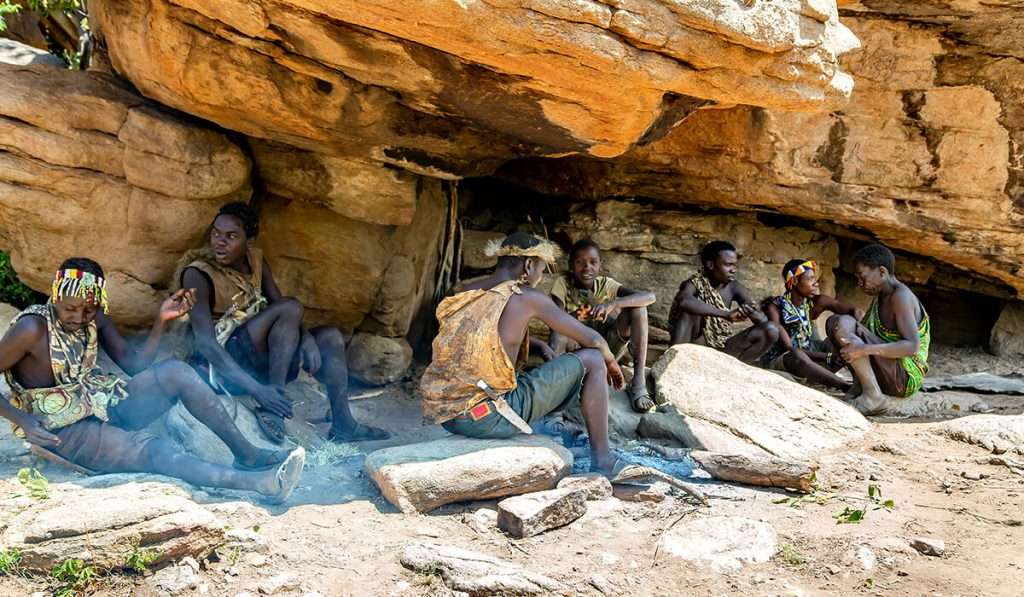
Back at the camp, it’s time to learn more about these people, of whom less than 1500 remain. The Hadzabe language is punctuated with a strange clicking noise that seems to come from the back of their throats.
We learn that their shelters are essential, made from grass and wood, though they seek refuge in caves in rainy times. The sun and moons are their gods, and when the sun goes down, the god is ‘sleeping’; its ‘baby’ the moon takes over until, at dawn, the sun wakes up once more.
A simple, collective lifestyle

The Hadzabe are Tanzania’s last permitted hunters. In addition to meat, animals yield their skins to be used as clothes and adornments, while bird feathers are used in the arrows. The deadly desert rose provides the serum to poison-tip the arrows, which bring down the larger animals.
Nothing is wasted, and everything is shared. While the men hunt, the women gather. They use their phenomenal knowledge of their environment to collect arrowroot and wild fruits.
Before we leave, the tribeswomen perform a joyous song and dance as I ponder how long these captivating people can survive with a lifestyle that is so at odds with the rest of the world.
It’s a question I cannot answer. I can only hope.
My Take on the Inside of the Hadzabe Community of Lake Eyasi
Step inside the Hadzabe Community of Lake Eyasi, and you’ll enter a world of ancient traditions and a deep relationship with Mother Nature herself. Deep in the eastern part of the shores of Lake Eyasi, in northern Tanzania, you’ll find this extraordinary community and get a rare glimpse into a way of life that has spanned thousands of years.
Though their community is remote, the Hadzabe reflect images that fill the villages and homes worldwide. Their homes carry the same resourcefulness and ingenuity found in family dwellings worldwide.
They strategically use the natural resources at their feet to meet their families’ needs. Life is just as vibrant here. Women cook the day’s catch, and stories and laughter fill the air throughout the village—evidence of a people who find joy, friendship, and community in sharing a meal.
As you walk through, you’ll find that life here is communal and that family is a community by every definition.
Bottom line?
Lake Eyasi can be found in the Great Rift Valley, which is south of the Serengeti National Park and southwest of the Ngorongoro Crater. Eyasi is a salt lake whose water levels are subject to dramatic changes with the seasons: in years with little rainfall, the dry season can result in the lake almost disappearing. It can then become capable of being crossed on foot, a valuable shortcut for the Hadzabe, Datooga, and other tribesmen who live in the vicinity.
Getting you there?
If you want to include an encounter with the Hadzabe hunters as part of your Tanzanian safari, contact Easy Travel today to plan a life-changing adventure. Our exceptional customer service staff loves building custom trips that meet your specific wishes and leave you with memories forever.
Frequently Asked Questions (FAQs)
Who is the Hadzabe tribe?
The Hadzabe tribe, also known as the Hadza or Hadza people, is one of the last hunter-gatherer tribes in the world. It lives in the Lake Eyasi region of Tanzania.
What is unique about the Hadzabe culture?
The Hadzabe culture distinguishes itself through its traditional reliance on hunting and gathering, eschewing modern agricultural practices. Their lifestyle fosters a profound bond with nature, as they intimately understand the land and its resources.
With a rich heritage immersed in tradition, the Hadzabe maintain customs and rituals that have endured for generations. Their unique way of life offers valuable insights into sustainable living and the harmonious relationship between humans and the environment.
Are the Hadzabe adept hunters?
The Hadzabe people are renowned for their remarkable hunting prowess, a skill deeply ingrained in their cultural identity. Their expertise in hunting is passed down through generations, showcasing a mastery of traditional techniques like bows, arrows, and spears.
Within their community, these methods are not just means of survival but symbols of their heritage and connection to the land. Through their hunting practices, the Hadzabe demonstrate resilience and adaptability in navigating their natural environment.
What is an early morning hunting excursion with the Hadzabe like?
Embarking on an early morning hunting expedition with the Hadzabe offers a firsthand glimpse into their time-honored traditions. As you join them in the hunt, you’ll immerse yourself in their ancient techniques, witnessing their skill and resourcefulness up close.
This unique experience provides insight into their hunting practices and a deeper understanding of their culture and connection to the land. Through this shared adventure, you’ll forge meaningful connections and gain a newfound appreciation for the Hadzabe way of life.
Can I observe an early morning hunting demonstration with the Hadzabe?
You can engage in or observe a captivating early morning hunting demonstration led by the Hadzabe. During this experience, they generously impart their wisdom, unveiling the intricacies of their hunting methods and strategies.
Through their demonstrations, you’ll gain invaluable insights into their deep-rooted connection to the land and the natural world. It’s a remarkable opportunity to witness their expertise firsthand and gain a profound appreciation for their ancient traditions.
How do the Hadzabe men hunt?
The Hadzabe men relied on ancestral tools like bows, arrows, and spears honed over centuries. Their hunting prowess is evident in their impressive agility and precision, showcasing a deep understanding of their environment.
These techniques passed down through generations, represent a rich cultural heritage and a symbiotic relationship with nature. Witnessing their skillful maneuvers offers a glimpse into the intricate balance between tradition and survival in Hadzabe society.
What makes the Hadzabe tribe the only tribe of its kind?
The Hadzabe tribe stands out as one of the few remaining hunter-gatherer societies, steadfastly preserving their ancient lifestyle amid modernization. They tenaciously cling to their cultural identity and traditional practices despite external pressures and societal changes.
Their resilience in maintaining their way of life reflects a deep-seated commitment to their heritage and values. Amidst a rapidly changing world, the Hadzabe serve as custodians of a way of life that embodies harmony with nature and the essence of human existence.
Do Hadzabe children gather fruits as part of their daily activities?
In Hadzabe culture, children gather fruits and other wild edibles, instilling essential survival skills early on. Their involvement in daily activities not only fosters self-reliance but also reinforces their connection to the land and traditional practices.
By contributing to the tribe’s food-gathering efforts, Hadzabe children play a vital role in sustaining their community’s livelihood. This hands-on learning approach prepares them for the challenges of their environment while nurturing a profound appreciation for nature’s bounty.
How do Hadzabe men cut wood?
In the Hadzabe community, men adeptly wield traditional tools to harvest wood, showcasing their ingenuity and environmental awareness. Employing axes or similar implements, they skillfully gather firewood essential for cooking and providing warmth.
Through these age-old methods, Hadzabe men demonstrate a deep connection to their surroundings, utilizing resources sustainably. Their proficiency in woodcutting fulfills practical needs and honors their cultural heritage and harmonious relationship with nature.
Are there other tribes similar to the Hadzabe in the Lake Eyasi region?
In the Lake Eyasi region, amidst various tribes, the Hadzabe stands out as one of the few remaining hunter-gatherer communities. Their distinctiveness lies in their adherence to traditional practices and a lifestyle centered around hunting and gathering.
As guardians of a unique cultural heritage, the Hadzabe cherish their ancestral customs and maintain a deep connection to their land. Amidst changing times, their resilience and commitment to preserving their way of life serve as a testament to their enduring legacy.
What is a hunting demonstration with the Hadzabe like?
Engaging in a hunting demonstration with the Hadzabe offers a chance to witness or join in a simulated hunt. Through this immersive experience, participants learn about the tribe’s hunting methods and cultural customs.
It serves as an enriching educational opportunity, shedding light on the intricacies of their traditional way of life. By partaking in this experience, one can deepen their understanding and appreciation of Hadzabe culture and their harmonious relationship with nature.
How does the Hadzabe tribe contribute to the preservation of hunter-gatherer traditions?
The Hadzabe tribe is a crucial guardian of hunter-gatherer traditions, sustaining practices like hunting and gathering while imparting cultural wisdom to the young. They strive to protect their rich heritage from modern pressures through their dedication to cultural preservation.
Their active involvement in safeguarding traditions ensures the continuity of their way of life for generations to come. Amidst societal changes, the Hadzabe remain steadfast in their commitment to preserving their unique identity and ancestral customs.
What role do Hadzabe women play in the tribe’s hunting and gathering activities?
In Hadzabe society, women actively hunt and gather alongside men, ensuring the tribe’s sustenance and sharing responsibilities equitably. They hold significant roles within the community and are engaged in food gathering, childcare, and various communal tasks.
Their involvement underscores the collaborative nature of Hadzabe life, where both genders contribute to the collective well-being. Through their multifaceted contributions, Hadzabe women exemplify resilience and strength, shaping the fabric of their society.
How do the Hadzabe maintain their cultural identity amidst modernization?
Despite external pressures from modernization, the Hadzabe prioritize the preservation of their cultural identity by safeguarding traditional practices, language, and social structures. Adapting to evolving socio-economic conditions, they deftly balance modern influences while cherishing their cultural heritage.
Their resilience in maintaining age-old customs reflects a deep commitment to their identity and values. Amidst the flux of change, the Hadzabe are custodians of a rich cultural legacy, resiliently navigating the currents of time.
Are there opportunities for cultural exchange with the Hadzabe tribe?
Visitors can partake in cultural exchanges with the Hadzabe tribe, delving into their unique way of life. Through immersive experiences, visitors gain insights into Hadzabe culture, fostering mutual understanding and appreciation.
These interactions offer valuable opportunities for learning and sharing, bridging cultural divides, and fostering connections. Engaging with the Hadzabe in this manner enriches visitors and the tribe, promoting cultural exchange and mutual respect.
What are some traditional ceremonies or rituals practiced by the Hadzabe tribe?
The Hadzabe tribe observes a range of traditional ceremonies and rituals, including those centered on hunting, gathering, initiation rites, and spiritual beliefs. These rituals hold profound cultural significance, binding the community together and upholding shared values.
Individuals reaffirm their cultural identity and strengthen social bonds through participation in these ceremonies. The rich tapestry of Hadzabe traditions reflects their deep-rooted connection to their heritage and the natural world.
How does the Hadzabe tribe interact with other tribes in the region?
The Hadzabe tribe engages with neighboring communities through trade, social interactions, and occasional conflicts or alliances, adapting to various circumstances. Their interactions with other tribes in the region contribute to a dynamic and ever-evolving relationship landscape.
This dynamic relationship underscores the Hadzabe’s ability to navigate complex social dynamics while preserving their cultural identity. These interactions forge connections that shape their communal experiences and traditions.
What are some misconceptions about the Hadzabe tribe?
Despite misconceptions, the Hadzabe tribe interacts with neighboring communities and adapts to socio-economic changes while safeguarding its culture. Acknowledging their connections outside their immediate community is crucial to fully understanding their way of life.
Appreciating the nuanced complexities of their lifestyle and cultural context is essential, and it goes beyond simplistic portrayals of isolation. Understanding their interactions and adaptations enriches our perception of the Hadzabe and their resilient cultural heritage.


















